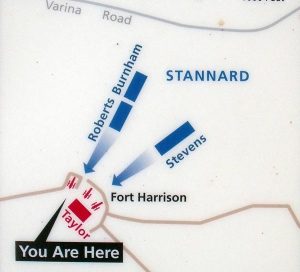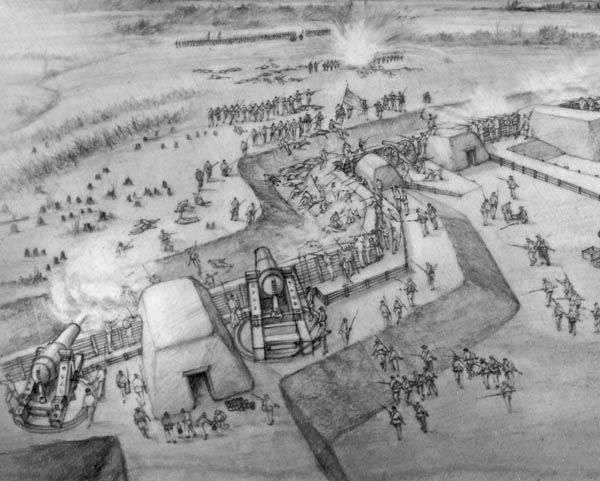Fallen Leaders: The Grizzly sensed death
Hiram Burnham sensed he would not return home alive as he rejoined his command in late September 1864. He was correct — by six days.

“Grizzly” for his large and fit physique and for his “stentorian” voice, which could carry in the Maine woods or on a battlefield. (Bangor Public Library)
Born in Machias in Maine’s Washington County in 1813 or 1814, the physically large and fit Burnham lived in Cherryfield about 30 miles to the west by the late 1830s. He ran logging camps in winter, owned a lumber mill, and commanded the Cherryfield militia company sent to guard the international border at Calais during 1839’s so-called “Bloodless Aroostook War.”
Due to his size and “stentorian voice,” local men called him “Grizzly.”1
By 1860 Burnham and his Nova Scotia-born wife, Elizabeth, had six children. He won election in 1860 as the Republican candidate for Washington County commissioner. Elizabeth died that August 15, and the oldest child (and son), Robert, died the next year.
While “no longer a young man” and with “his thin locks well sprinkled with gray,” Burnham raised in spring 1861 an infantry company drawn mainly from western Washington County. Governor Israel Washburn Jr. made Burnham lieutenant colonel of the 6th Maine Infantry Regiment.
Its colonelcy went to Abner Knowles, a 48-year-old Bangor attorney who “just didn’t have a clue,” said modern 6th Maine historian James H. Mundy. The 6th Maine mustered in Portland on July 15. Knowles resigned December 11, and Washburn made Burnham the colonel on December 23.
Charles A. Clark, the Foxcroft Academy drop-out who rose to adjutant, described the 6th Maine as “a happy combination of the sailor, the lumberman, the student, the farmer, the merchant, and the laborer, with a lucky absence of the politician.” He became particularly close to Burnham.

The Grizzly led the 6th Maine at Williamsburg, on the Peninsula, and elsewhere. Perhaps his greatest moment occurred on May 3, 1863, when he took his four-regiment Light Brigade up Marye’s Heights at Fredericksburg. The army soon disband that brigade and returned him to regimental command.
Ill health sent Burnham home in autumn 1863. After presiding at courts martial, he rejoined the army in February 1864. Finally promoted to brigadier in April, he took over the 2nd Brigade, 1st Division (Brig. Gen. William T. H. Brooks), XVIII Corps (Maj. Gen. William “Baldy” Smith). With Burnham came the young Clark, “commissioned captain and [appointed Burnham’s] assistant adjutant-general” by President Abraham Lincoln.2
Burnham and his brigade proved their mettle at Bermuda Hundred, particularly during the mid-May fighting near Drury’s Bluff. There the 2nd Brigade dealt with “a furious attack” on Monday, May 16. “The fight continued to rage hotly,” Burnham said. His brigade held “its position with great tenacity” until ordered by Brooks to withdraw about 10 a.m.
Bermuda Hundred combat cost Burnham “418 officers and men.”
The 2nd Brigade fought at Cold Harbor and participated in a June 15 attack at Petersburg. Deteriorating health brought Burnham to Cherryfield in August to spend “a few quiet weeks of rest with his family.” He “returned to the field” the next month.
While passing through Portland on Friday, September 23, Burnham “conversed cheerfully with all,” but sensed a dark future. He expressed “some forebodings that he himself would not survive to witness the crowning victory,” a newspaper correspondent noted.3

Burnham rejoined the 2nd Brigade on Tuesday, September 27. Native Vermonter Brig. Gen. George J. Stannard now led the 1st Division; Maj. Gen. Edward O. C. Ord commanded XVIII Corps, “then on duty between the James and Appomattox Rivers.”
After dark on September 28, Ord took Stannard’s division and the 2nd Division (Brig. Gen. Charles A. Heckman) over a pontoon bridge laid across the James River at Aikens’ Landing. With “about 4,000 men” Ord swung north to advance up the Varina Road and attack Confederate defenses near the river.
Commanded by Maj. Gen. David B. Birney, X Corps would advance farther east to “reach Richmond via Deep Bottom and the New Market road.” Reinforced by Brig. Gen. Charles J. Paine’s 3rd Division (eight USCT regiments) of XVIII Corps, Birney’s “column was about 10,000 strong,” Ord said. The resulting battle went into history as Chaffin’s Farm or New Market Heights.
Ord was ordered to capture Fort Harrison, sited atop a hill. Burnham’s brigade led the Thursday attack across some 1,400 yards of open terrain. “Exposed to a plunging fire of artillery and musketry, galling in the extreme,” the Yankees “pushed gallantly forward,” reached “the base of the hill” on which Harrison perched, and “came to a halt, from sheer exhaustion,” Stannard said.
Not “until quite near the works where” Confederate fire “was perfectly terrific” was “a momentary halt made,” said Clark. Burnham studied the situation.
“Forward!” he ordered.
Riding up the hill, Burnham halted at the ditch “so deep and wide,” dismounted, handed the reins to an orderly, “and entered [Harrison] on foot” with Clark nearby.

“Officers and men jumped into the ditch,” worked their way “along round so as to cut off and capture” Confederates defending “the extreme bastion, and helped each other up the parapet at this point,” said Ord.
As Burnham took some 200 men to the right inside Harrison, a minie round struck his abdomen. Clark got the Grizzly “into a log cabin” and examined the wound. The general briefly “recovered, and seemed hopeful and cheerful” and “did not feel as if his wound was mortal.”
Clark detailed some soldiers to carry Burnham in a blanket to an ambulance. “He failed very rapidly, and was conscious he was failing,” Clark said.
“Say to my family and friends, that I have tried to do my duty,” Burnham said shortly before he died inside an ambulance.
“I noticed that his features were changing, and jumped in and raised his head, and asked him if he knew me,” Clark recalled. “He smiled, and expired almost instantly.”
Clark escorted Burnham’s embalmed body to Cherryfield, where residents organized a funeral “befitting the noble dead.” The funeral took place on Friday, October 7. At 2 p.m. around 1,500 people escorted the hearse to “the Baptist meeting-house.”
Behind the hearse walked “a favorite bay horse” of Burnham’s, “fully equipped for mounting, bearing the emblems of mourning.” Sixth Maine veterans also accompanied their commander, eulogized during a lengthy service and then buried in his family’s lot at Pine Grove Cemetery on the road (modern Route 1) running from Cherryfield to Harrington.4
1 Brig. Gen. Hiram Burnham, Report of the Adjutant General of the State of Maine, 1864-1865 (Augusta, ME, 1866), 324-325. Hereafter known as MAGR.
2 1860 U.S. Census for Cherryfield; James H. Mundy, No Rich Men’s Sons: The Sixth Maine Volunteer Infantry (Cape Elizabeth, ME, 1994), 19, 31; MAGR, 1861 (Augusta, ME, 1862), 310, 329; Charles A. Clark, Campaigning With the Sixth Maine Des Moines, Iowa, 1897), 3, 50; Mundy, No Rich Men’s Sons, p. 31; MAGR, 1864-1865, 325-328
3 Brig. Gen. Hiram Burnham, War of the Rebellion: A Compilation of the Official Records of the Union and Confederate Armies, 36 (2), 132-136; MAGR, 1864-1865, pp. 327-328; Portland Daily Press, Monday, October 3, 1864
4 Maj. Gen. Edward O. C. Ord, OR, 42 (1), 793-795; Bvt. Maj. Gen. George J. Stannard, OR, 42 (1) 798-799; Clark, Campaigning, 51-52; Funeral Ceremonies of General Burnham, Ellsworth American, Friday, October 14, 1864
Thanks for this. Burnham was a good soldier and leader who deserves more recognition.
Hi, Chris. Unfortunately, Burnham receives little attention in Maine.
Very impressive man. I would like to know his motivation for raising a regiment and leading it. You state he was a Republican. Was he an abolitionist or a save the union ma or both?
None of the material that I have read about Burnham link him with abolitionism. I believe he was “a save the Union guy.”